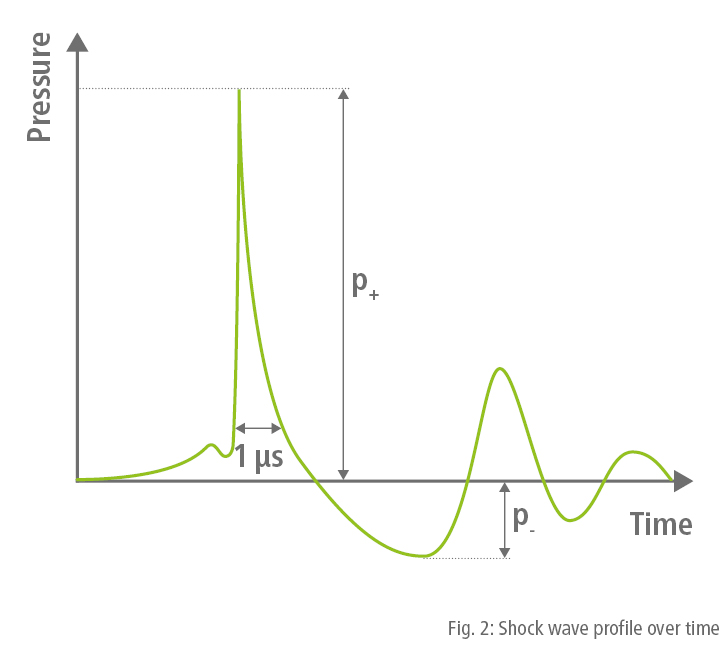Treat Smarter, Not Harder
Among shockwave therapy practitioners, there is a commonly held assumption that the success of treatment is directly correlated with higher power levels and the resulting energy delivered (mJ/mm2). It is important however, to challenge this misconception and emphasise the need for personalised treatment dosages based on each patient’s specific clinical presentation and the chronicity of their condition. By dispelling this myth, we can gain a clearer understanding of the optimal protocols for effective treatment.
The mechanical and physical impact on tissues, exposed to shockwave has been found to depend on the flux density of energy delivered. Animal studies, utilising shockwave in tendons have shown that low to moderate energy showed positive stimulatory effects, whereas very high energy levels had significant inhibitory effects. (Rompe et al, 1998; Orhan et al, 2004). Consequently, it is recommended to exercise caution when administering shockwave therapy with high energy levels to patients suffering from tendon disorders to minimise the risk of adverse effects (Notarnicola & Moretti, 2012).


Figure 1: Schematic Illustration of pathophysiology in chronic tendon pain (Source: Ackermann, P.W., Alim, M.A., Pejler, G. and Peterson, M., 2023. Tendon pain–what are the mechanisms behind it- Scandinavian Journal of Pain, 23(1), pp.14-24)
In healthy tendons nerve fibres, blood vessels and inflammatory cells are confined to the tendon surrounding structures. Thus, acute inflammation and acute pain may occur in the tendon surrounding structures as paratendinitis, enthesitis etc. In response to e.g, repetitive mechanical stimuli peripheral nerve endings and tendon cells (tenocytes) can release neurotrophic and neuroinflammatory mediators.
Potential Adverse effects of Excessive energy
Very high energy during shockwave treatment in tendons can potentially lead to several complications in tendons, which include:
| Effect | Description |
|---|---|
| Tissue Damage | Excessive energy levels, could potentially result in tissue damage within the treated tendon. This damage may include microtrauma and disruption of the extracellular matrix. |
| Increased Pain and flare-ups | Higher energy levels can induce heightened pain during and after the shockwave therapy session. This can be attributed to the intensity of the treatment and the potential tissue damage caused by excessive energy. |
| Delayed Healing | Contrary to the desired therapeutic effects, elevated energy levels may impede the healing process in tendons. Instead of promoting tissue repair, excessive energy can lead to prolonged recovery times and hinder the overall healing trajectory. |
| Aggravation of Symptoms | In some cases, higher energy output can exacerbate the patient's existing symptoms. This can manifest as increased inflammation, pain, or discomfort in the treated tendon area. Further, it may reduce a patient's tolerance for shockwave therapy sessions. The discomfort associated with excessive energy can lead to treatment discontinuation or reduced compliance. |
Tailoring Dosage for Specific Therapeutic Effects
In clinical practice, it is essential to customise the dosage of shockwave therapy to achieve the intended therapeutic effects. For example, a range of 0.5 to 1.5 bar is primarily used for pain relief by stimulating sensory nerves and desensitising tissues. Generally, the safe range for most tendons in both upper and lower limbs is generally, considered between 1.5 to 3.5 bar to optimise outcomes without increasing the risk of flare-ups or symptom aggravation.
Lack of High-Quality Trials Supporting Higher Bar Pressure
To date, there are no high-quality trials demonstrating that higher bar pressures lead to better therapeutic outcomes for patients with tendon disorders (Reilly et al, 2018). Additionally, there is a concern about potential tissue damage, especially in patients with compromised microcirculation and reduced healing capacity due to tendinopathy.
Treatment Effectiveness is Multi-factorial
Although some manufacturers suggest that higher power translates to better treatment outcomes, it is important to consider that treatment effectiveness is not solely determined by power or energy delivered. Optimal treatment effects result from a combination of factors, including energy concentration, treatment technique, patient characteristics, and clinical evidence.

Figure 2; Schematic illustration of pressure wave characteristic and Radial Pressure wave Therapy (Source: Zwerver, J., Waugh, C., van der Worp, H. and Scott, A., 2016. Can shockwave therapy improve tendon metabolism?. Metabolic Influences on Risk for Tendon Disorders, pp.275-281)
Considering Factors Beyond Bar Pressure
Different bar pressures in shockwave therapy may target specific structures, such as sensory nerves and tendons. However, assuming that higher pressure automatically leads to better outcomes is unfounded. Optimal treatment parameters should be based on comprehensive assessments and evidence-based guidelines, taking into account factors beyond bar pressure alone. The expertise of a trained healthcare professional is crucial to ensure safe and effective shockwave therapy.
Conclusion
Just as a symphony orchestra requires a harmonious blend of various instruments playing in sync to create beautiful music, shockwave therapy relies on a careful balance of treatment parameters and individualised approaches to achieve optimal patient outcomes. It’s not about cranking up the volume to the highest level; it’s about conducting a precise composition tailored to the unique needs of each patient. Just as a skilled conductor brings together different musical elements to create a masterpiece, a trained healthcare professional orchestrates the right combination of energy concentration, treatment technique, and clinical evidence to deliver a truly effective shockwave therapy experience.
Ultimately, the effectiveness of shockwave therapy relies on a comprehensive understanding of the therapy and the specific needs of individual patients, rather than relying solely on power output comparisons between devices.
References
Notarnicola, A. and Moretti, B., 2012. The biological effects of extracorporeal shock wave therapy (eswt) on tendon tissue. Muscles, ligaments and tendons journal, 2(1), p.33.
Orhan Z, Cam K, Alper M, Ozturan K. The effects of extra-corporeal shock waves on the rat Achilles tendon: is there a critical dose for tissue injury? Arch Orthop Trauma Surg. 2004;124(9):631–635
Reilly, J.M., Bluman, E. and Tenforde, A.S., 2018. Effect of shockwave treatment for management of upper and lower extremity musculoskeletal conditions: a narrative review. PM&R, 10(12), pp.1385-1403.
Rompe JD, Kirkpatrick CJ, Kullmer K, Schwitalle M, Krischnek O. Dose-related effects of shock waves on rabbit tendo Achillis: A sonographic and histological study. J Bone Joint Surg Br. 1998;80-B:546–552.




